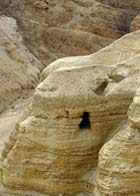Israelite Religion & Culture
 A Dead Issue?
A Dead Issue?Monday, February 15, 2010 by Elli Fischer | Jewish Ideas Daily » Daily Features
Since the electrifying discovery of the Dead Sea Scrolls at Qumran in the late 1940's, the scholarly consensus has been that they were produced by the Essenes, a small Second Temple-era Jewish sect known to us from Josephus. Last year, a book by Rachel Elior, Memory and Oblivion: The Secret of the Dead Sea Scrolls (Hebrew), upended this seemingly settled issue by contending that, in fact, the Essenes never existed. Elior's revolutionary thesis, argued with force and stridency, has been discussed in major mainstream publications from Israeli newspapers to Time magazine. But the controversy, and clashing assessments of her achievement as a historian, have...
Editors' Picks
Tangled Up in What? Joel Davidi, Toledot Am Ha-Sefer. Josephus refers to "a remembrance upon the arms" (which may or may not be figurative); Aristeas refers to a "sign around the hand" (same). Why are the earliest Jewish sources on tefillin so ambiguous?
Hitting Bedrock Nadav Shragai, Israel Hayom. Two-thousand years after Herod's builders laid them, the foundation stones of the ancient Temple of Jerusalem have at last been uncovered.
Superhuman Discovery Arieh O’Sullivan, Jerusalem Post. Muscles bulging, a lion skin draped over his shoulder, the Greek mythical hero Hercules has reappeared—headless—in a Roman-era bathhouse in northern Israel.
From Jerusalem's Ancient Tunnels Associated Press.
On the eve of Tisha b'Av, archaeologists revealed artifacts newly unearthed from the great Jewish revolt against Rome (67–70 C.E.), including coins minted by the rebels and a stone incised with a sketch of the Temple menorah.
For Whom the Bell Tolls Associated Press. Did a tiny ancient golden bell, found near the Temple Mount and making a faint metallic clink, once adorn a priestly garment?
Sabbath Rock BibleWalks. Newly discovered: carved into a rock in Lower Galilee is the word shabbat, likely a Roman-era marking of the furthest point to which local Jews could travel on the day of rest.
Studying the Dead Sea Scrolls Jean Duhaime, H-Net. In a collection of essays, scholars consider and reconsider their methods of understanding the ancient manuscripts and the world in which they were composed.
Prayer Space Joey Corbett, Biblical Archaeology Review. Archaeologists working in the eastern Galilee have unearthed three ancient synagogues, one of them, at Magdala, among the oldest ever found.
The Tombs Speak Jacki Lyden, National Public Radio. At the Roman-era burial site of Beit Sh'arim, messages in Hebrew, Aramaic, and Greek, incised into stone coffins, reflect the inner world of an ancient Jewish community.
The Eye of the (Archaeological) Storm Israel Finkelstein, Forward. Whatever the controversial expeditions in the City of David turn out to have yielded, they have definitively exposed the baselessness of Palestinian claims about the site.

